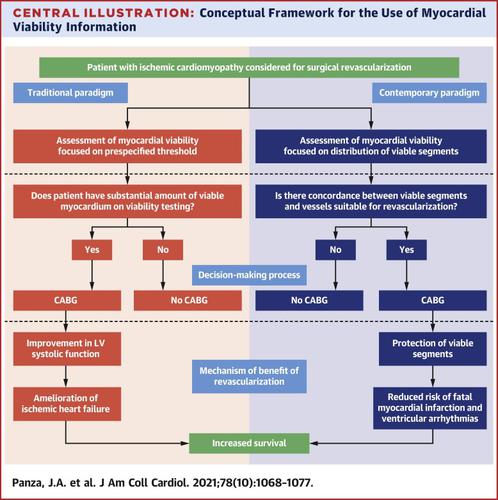Journal of the American College of Cardiology ( IF 21.7 ) Pub Date : 2021-08-30 , DOI: 10.1016/j.jacc.2021.07.004 Julio A Panza 1 , Lukasz Chrzanowski 2 , Robert O Bonow 3

|
Ischemic cardiomyopathy results from the combination of scar with fibrosis replacement and areas of dysfunctional but viable myocardium that may improve contractile function with revascularization. Observational studies reported that only patients with substantial amounts of myocardial viability had better outcomes following surgical revascularization. Accordingly, dedicated noninvasive techniques have evolved to quantify viable myocardium with the objective of selecting patients for this form of therapeutic intervention. However, prospective trials have not confirmed the interaction between myocardial viability and the treatment effect of revascularization. Furthermore, recent observations indicate that recovery of left ventricular function is not the principal mechanism by which surgical revascularization improves prognosis. In this paper, the authors describe a more contemporary application of viability testing that is founded on the alternative concept that the main goal of surgical revascularization is to prevent further damage by protecting the residual viable myocardium from subsequent acute coronary events.
中文翻译:

缺血性心肌病手术血运重建前的心肌活力评估
缺血性心肌病是由瘢痕与纤维化置换以及功能失调但有活力的心肌区域相结合引起的,这些区域可以通过血运重建改善收缩功能。观察性研究报告称,只有具有大量心肌活力的患者在手术血运重建后才有更好的结果。因此,专门的无创技术已经发展到量化存活心肌,目的是为这种形式的治疗干预选择患者。然而,前瞻性试验尚未证实心肌活力与血运重建治疗效果之间的相互作用。此外,最近的观察表明,左心室功能的恢复并不是手术血运重建改善预后的主要机制。在本文中,









































 京公网安备 11010802027423号
京公网安备 11010802027423号